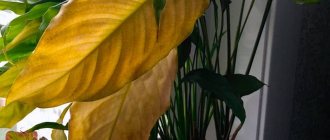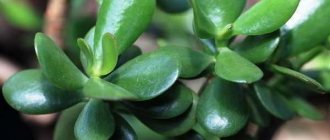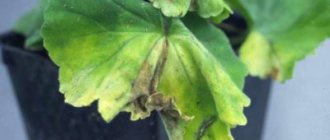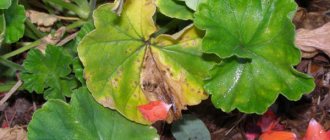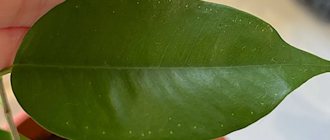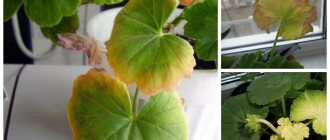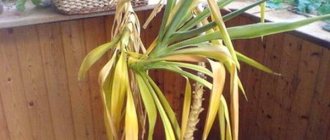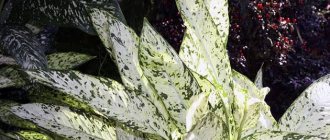Zamioculcas is an evergreen plant native to tropical Africa.
Dear readers! For you, we have created communities on social networks in which useful articles and interesting ideas are published several times a day! Subscribe and receive useful content in a convenient format!
This flower is popularly called the dollar tree. It is believed that if you plant zamioculcas at home, the owners will be guaranteed success in money.
The flower is not picky about its conditions and is easy to care for. But, like any other plant, zamioculcas can get sick or suffer from parasites. Among the most common problems are fungus, damage to the root system and yellowing of leaves.
Next, we will talk about why your zamioculcas got sick and how to help it.
Reasons related to leaving
The dollar tree is a hardy plant that can successfully resist many diseases and pests.
But sometimes the owner may notice how his pet’s leaves have begun to turn yellow. There are several reasons for this phenomenon.
First, let's look at the reasons related to flower care
Features of watering
Very often, dollar tree leaves turn yellow due to improper watering.
Zamioculcas does not like wet soil. In summer, the soil in the pot should dry out a little. It is also undesirable to have moisture in the pan. Therefore, if water has accumulated there after watering, it must be drained.
In spring and summer, the flower needs to be watered once every 7-10 days.
In winter, the dollar tree enters a dormant period. At this time of year it needs even less moisture. One watering per month will be enough.
Please note that you need to water the plant with water at room temperature. You should not use freshly drawn tap water for these purposes.
IMPORTANT!
If you are in doubt about whether to water Zamioculcas, it is better to wait 1-2 days. The flower will not dry out. It will be much worse if you “flood” it.
Wrong location of the flower
Location of Zamioculcas in the back of the room
Dollar Tree, being a native of Africa, loves bright light and warmth. Therefore, it is best to grow it on a south-facing window, and in summer take it out onto the balcony, veranda or yard.
But at the same time, the flower will not wither on the north side. It will just be a little smaller in size.
High humidity and low temperatures are very harmful for Zamioculcas. Such conditions of detention negatively affect the plant’s immunity.
Therefore, if the leaves of a flower begin to turn yellow, check its location. This is especially true for the cold season.
Drafts
It is highly undesirable to leave a dollar tree in a draft, especially in winter. If a warm summer breeze from an open window doesn’t do anything bad to the zamioculcas, then the winter draft causes the plant’s leaves to turn yellow and fall off. Dark spots appear on them. Young shoots are especially susceptible to this destructive process.
Sunburn
The dollar tree loves sunlight. But this does not mean that zamioculcas does not need to be protected from direct sunlight.
The plant can be exposed to the heat without harm only outside, where it is cooled by the movement of air masses. If you don’t take the flower out into the fresh air in the summer, then place it in the back of the room. This will protect your pet from harmful direct rays of the sun.
Prolonged exposure of the plant to the sun leads to burns, as the temperature of the leaves rises and cooling does not occur. As a result, they begin to turn yellow and then dry out completely.
Yellowing of zamioculcas leaves
Affected leaves need to be cut off at the root. But such pruning at the height of the season harms the appearance of Zamioculcas. The flower is slow-growing and is not able to restore green mass at a rapid pace.
If you do get burned, then you urgently need to rearrange the flower or shade the place where it is located. The leaves need to be treated with an adaptogen.
Frostbite
Zamioculcas leaves also turn yellow due to frostbite. This can happen, for example, if you ventilate a room in winter. And at the same time, the dollar tree stands under the open window. Or if in the fall a flower located in the open air was hit by the first frost.
In these cases, you need to remove the plant from the cold and treat the affected leaves.
Temperature changes
Zamioculcas withstands changes in ambient temperature. It feels good both at 12 degrees in winter and at 26 degrees in summer.
But keep in mind that the flower really does not like sudden changes in temperature. For example, if you decide to move the pot from the room to a cold balcony or corridor, the leaves of the plant will begin to turn yellow.
Therefore, to prevent your flower from suffering, provide it with a stable temperature regime.
Air humidity
The dollar tree is not picky about indoor air humidity and does not require spraying. But there is still no need to keep the plant in extreme conditions. And in too dry a climate, and with high humidity, the flower may feel unwell.
If the air in your apartment is too dry in winter, then wipe the leaves with a damp cloth. Sometimes you can spray the plant, but you shouldn’t overuse it.
IMPORTANT!
The most important rule for caring for zamioculcas is moderation. There is no need to arrange a survival quest for your green pet.
Why is it important to stop pests?
Zamioculcas leaves are covered with wax. This is a protective barrier against parasites. But if there is a plant infested with pests nearby, Zamioculcas will still become infected. Most often it is harmed by aphids, mealybugs, scale insects and spider mites. In waterlogged soil, next to a rotten tuber, fungus gnats and larvae of fungus gnats appear.
Table: parasites that cause the plant to rot, turn yellow, dry out, stop developing, even die
| Pest | Appearance of the parasite | Symptoms of the lesion | Struggle | Prevention |
| Spider mite. Feeds on plant sap | Tiny, barely visible insect | Signs of its presence are white cobwebs and red-brown spots on the leaves. The plant stops developing. Ticks multiply quickly in a dry, poorly ventilated area | Traditional methods - infusions of tobacco or soap - are not very effective. It is better to spray the plant with a solution of a systemic insecticide, for example, Intavir, Nearon or Sunmite. | For prevention, wash zamioculcas in the shower, these insects die from moisture |
| Mealybug. Sucks juice from leaves, leaves sticky discharge | Hidden under clumps of sticky white lint-like substance | The insect sucks the juice from the leaves, leaving a sticky secretion on which sooty fungi can develop | Remove pests by hand using a damp cloth. After this, wipe or spray the plant with a weak alcohol solution. If the lesion is extensive, treat with insecticides (Fufanon, Intavir, Decis or Actellik). | Inspect your zamioculcas regularly, especially in the off-season. This pest is afraid of moisture and prefers dry conditions. Keep the plant clean and remove any dried leaves. Plants that regularly wash their leaves are rarely affected by scale insects. |
| Aphid | Small insects of various colors - white, green, brown, black. They usually settle on the underside of leaves, quickly growing to huge colonies | The presence on the plant of a sticky secretion of aphids, the so-called honeydew. Wilting primarily of young leaves. Aphids are the most dangerous plant pest. These parasites, drinking vital juices from shoots and roots, can lead to the death of the plant. | Treat the plant with a special aphid repellent, following the instructions for the product, or with a soap solution with the addition of nicotine sulfate (1 g per liter). Suitable for home use: Intavir, FAS, Karate |
|
| Shchitovka | Females have no legs, no wings, no eyes, no antennae, but they have well-developed mouthparts of the piercing-sucking type. While the females are young and the shield covering the insect is soft, scale insects can move. When the scutellum matures, the insects become immobile | At the site where the scale insect is attached to the leaves, yellow spots appear, which grow in size as the cell sap is sucked out. Then the leaf turns completely yellow or brown, curls and falls off, the plant stops growing, the branches become bare, then the whole bush begins to dry out and eventually dies. | First of all, remove the insects with a damp cloth. Treat the plant thoroughly with an insecticide. It is rare to kill a pest the first time. Carry out treatments until final victory | Good care, timely watering, frequent ventilation, regular inspection of stems and leaves, especially from below, timely replacement of soil or its top layer, careful placement of “newcomers” on a common window sill, subject to quarantine time. Don’t forget about cleanliness: dirt, dust, sticky secretions are a favorable environment for pests |
| Fungus gnats (or flower gnats) | Small flying insects that live in waterlogged soil | Fungus gnats themselves do not harm the plant. Worm-like larvae that live in the soil and feed on young roots are dangerous. | To get rid of pests, you need to change the soil. Remove the zamioculcas from the pot, remove all the soil, and dry the root system. Sterilize the pot and new substrate. Plant the zamioculcas again, having first removed suspicious roots and parts of the tuber, and sprinkled the cuts with charcoal. Do not water for 2-3 weeks. | For prevention, get rid of midges indoors using aerosols Raptor, Raid, Dichlorvos-neo. Use soil insecticides Baduzan, Grom-2 against larvae. |
| Podura (springtails) | Jumping insects that settle in waterlogged soil | The appearance of poduras is a signal that you are flooding the zamioculcas and it is in danger. | If there are few insects, sharply limit watering and they will die on their own. In case of severe damage, check the root system for rot. If you find a problem, proceed as you would when fighting fungus gnats. | Prevention - correct watering regime, granules of the drug Baduzan in the soil |
Natural aging
Another reason for yellowing of zamioculcas leaves is aging. It is easy to determine that yellowness appeared due to natural reasons. The dollar tree first gets rid of 2-3 yellowed leaves at the base of the branch. While at its end new leaf plates are formed. This is a natural process that indicates proper care of the plant.
You need to worry if the flower has slowed down its growth and does not want to renew its foliage. This indicates illness. This means we need to look for its cause.
Zamioculcas gets rid of old foliage
INTERESTING!
One cutting of Zamioculcas cannot have more than 17 leaves at the same time. Therefore, its old leaves periodically fall off. There is no need to be afraid of this if the plant looks healthy on the outside.
Zamioculcas in natural and home conditions
Zamioculcas is a native of Africa. But unlike capricious tropical plants, this creature is by no means gentle. In the wild, Zamioculcas is used to tolerating drought and extreme heat. He adapted perfectly to this extreme. The tuberous root accumulates moisture, which, if necessary, maintains the viability of the plant. Thick leaf bases serve the same purpose. The petioles (axes or rachis) of pinnate leaves grow directly from the tuber. They reach a meter in length; there is a compact form no more than 60 cm high. Dense leathery leaf segments (they are also called feathers) are located on the rachis. They are covered with a wax film and consume moisture very sparingly.
Zamioculcas is an unpretentious plant and an excellent find for interior design.
At home, Zamioculcas, popularly called the dollar tree, is as ascetic as its wild relative. This plant does not require excessive care . Give the African native a moderately warm (in winter not lower than +15 degrees) and sunny place in your home. He will feel good near a south-facing window. In the north, Zamioculcas will also grow, but much more slowly. And this plant is already developing slowly, the growth of 2-3 leaves per year (not to be confused with feathers) is normal development.
Zamioculcas leaf plates are covered with protective wax, which prevents moisture evaporation
Excess and lack of fertilizing
Like any living organism on the planet, zamioculcas needs proper and timely nutrition. A lack of nutrients leads to yellowing of the leaves, loss of appearance and general weakness of the plant.
The dollar tree accepts both organic and mineral fertilizers well. The ideal feeding scheme is to alternate types of fertilizer.
You can also do the fertilizing yourself. Professionals advise using sugar water, ground eggshells, yeast, citrus zest and banana peels as fertilizer.
The first time you need to feed a flower is when planting it in a pot. During the growing season, fertilizing should be done 2 times a month. When buds appear on the flower, feeding must be stopped until next spring.
Frequent fertilization is undesirable and can lead to plant disease.
Zamioculcas grows slowly, so excess feeding will only clog the soil and negatively affect the general condition of your pet.
IMPORTANT!
If you have “overfed” the plant, then you need to take the following measures:
- the flower must be removed from the pot;
- thoroughly clean from spoiled soil;
- check the roots of the plant;
- if there are damaged areas, remove them;
- transplant into another pot.
Leaves turn pale and stretch out
Symptoms
Young shoots are too long, elongated (the internodes between the leaf blades increase significantly), pale , often underdeveloped and weak.
Maja Dumat / Flickr.com
Cause
Since Zamioculcas is a generally very patient and hardy plant, the reason for this condition can only be a combination of several factors .
Too indoor air in winter lack of minimally adequate lighting during the period of active growth, excess nitrogen fertilizers and excessive watering . The problem lies in the combination of several or all of these factors at once.
- As a rule, this happens in winter or early spring , when the plant should be kept cooler (+16-18 ºС), and watering should be more than moderate.
- If this happens during a period of active growth , then the reason may be a lack of nutrients or very poor lighting .
pxhere.com / Personal archive
Recent transplant
Transplanting Zamioculcas
Like any plant, Zamioculcas needs to be replanted into a larger pot from time to time. At first, the flower will simply settle into a new place and spend all its energy developing roots to fill the entire space with them.
To ensure a successful transplant, be extremely careful and try not to damage the plant tubers. Any wound can lead to rotting and yellowing of the foliage. Therefore, after removing the plant from the old pot, you need to carefully examine its roots for wounds and cuts.
If you accidentally injured a flower, the wound should be treated with cinnamon or charcoal powder. After treatment, the tubers should be exposed to air for a while so that the wounds heal. The dollar tree can then be planted in a new pot.
Zamioculcas stopped growing
Zamioculcas is generally a slow-growing plant, and if it does not show signs of growth in winter , then this is normal and is no need to worry until spring
If this happens during the period of active growth (from spring to autumn), then the cause may be a lack of nutrition or a too cramped pot.
- In such a situation, the plant needs to be replanted , moved to a brighter place and, after a month or two, begin regular feeding . And Zamioculcas will definitely give you new shoots.
Mr.Rosewater / Personal archive
Root problems and damage
Roots are the most important part of Zamioculcas. Root disease can lead not only to yellowing of the leaves, but also to the death of the plant.
There are 2 main problems:
- rotting of the root system;
- tuber damage.
If your pet's roots begin to rot, then with a high degree of probability you have “flooded” it. Excess moisture causes fungus to appear in the soil, which causes rot.
In this case, zamioculcas must be completely cleared of old wet soil, treated with a systemic fungicide, sprinkled with activated carbon or ash and replanted in dry soil. The soil must first be disinfected by pouring boiling water on it or placing it in the microwave for a couple of minutes.
The other most common problem with Zamioculcas roots is damage to the tuber. Most often this happens during transplantation.
If you do not notice the wound in time, it may become infected from the soil. If the infection begins to spread throughout the tubers, then only pruning the infected part can help. The cut area must then be treated with ash or activated carbon.
Zamioculcas root system
How to save a dying zamioculcas
Zamioculcas enjoys the fame of an indestructible plant. But this is an exaggeration. If you do not pay attention to the distress signals that the flower sends, and calmly watch how it withers, death is inevitable. However, a florist who is attentive and sensitive to the mood of the plant will be able to literally pull the poor thing out of the other world.
To help Zamioculcas, you will have to remove it from the pot
Zamioculcas turned yellow and began to wither and dry out.
The plant has begun to turn yellow, but the cuttings are drying out and not withering. And you definitely didn’t overwater the soil of your sick pet. Is the lump of soil dry and falling away from the walls of the pot? This means that Zamioculcas is suffering from drought. It began to consume reserves of moisture and nutrition from the tuber and the base of the leaves. Make sure of this by removing the plant from the pot. The tuber must be free of rot. In this case, remove the yellowed leaves, return the zamioculcas to the pot and water it using the immersion method: pour water into a large container and dip the plant with the pot there. After this, let the soil dry. And only after that, start regular watering, preferably in a tray. Do not overdo it so as not to flood the plant.
Reanimation of the dollar tree
- Start by inspecting the aboveground part of the plant, examining the leaves for pests.
- If parasites are found, start fighting them.
- If there are no insects, explore the underground part. Remove the zamioculcas from the pot.
- Shake the soil off the roots or rinse it off with warm water.
- Pay attention to the condition of the soil. Sticky and wet means you have flooded the plant.
- Inspect the tubers and roots; if there is rot, remove and sprinkle the sections with crushed coal, sulfur, cinnamon, or fill them with green paint. Before this, they can be kept in a solution of manganese or fungicide.
- Dry the zamioculcas roots well, leaving them out of the soil for a day.
- Replant the plant in fresh soil with a high sand content and do not water for 2 weeks, and then do it very sparingly, 3-4 days after the entire lump of earth has dried out.
Video: saving zamioculcas with black rotten roots
When the entire underground part rotted, began to turn black and die
You took the zamioculcas out of the pot, exposed the root system and saw that the tubers had rotted completely. Don't give up, try to save the plant by rooting the leaves. Do not use yellowed parts for cuttings, only green and elastic ones. They can be rooted in a substrate with a large amount of sand or in water to which activated carbon has been added.
Video: twigs gave the dying zamioculcas new life
Diseases and pests
There are two types of diseases that Zamioculcas can be susceptible to:
- fungal infections (fusarium, late blight, anthocrosis);
- bacterial infections (wet rot, dry rot).
The dollar tree is rarely attacked by pests because its leaves are covered with a protective waxy coating.
Only scale insects, spider mites, aphids and mealybugs can cause real harm to the plant. It is these parasites that are able to overcome the protective layer of the flower.
If you notice pests, you need to take the following measures:
- isolate the diseased plant;
- cover the soil with foil;
- collect parasites with your hands;
- wrap the flower in alcohol-soaked cloth;
- treat the affected areas with soap or tobacco solution;
- wash the leaves with clean water;
- treat with insecticides.
What diseases affect Dollar Tree?
Sometimes with a newly brought flower you can introduce a fungal disease into your collection. Experienced flower growers recommend quarantining newcomers for 2 weeks, and then it will be clear whether he is infected or not.
Anthracnose
A fungal disease that attacks the leaves and stems of a plant.
Black and brown spots appear on them and grow over time. Most often, this fungus appears in greenhouse conditions , when the room is warm and humid.
This disease is not difficult to survive cold weather and therefore, in order to completely get rid of it, the plant must be treated with fungicides:
- Bordeaux mixture;
- Colloidal sulfur;
- Copper kuparos.
Powdery mildew
Powdery mildew appears in the warm season plus increased watering.
It is easy to notice by the coating on the plant, it looks like flour.
When the disease occurs, the affected leaf blades become covered with a powdery coating and die off after a while. Therefore, treatment begins with:
- Topaz;
- Speed
Sooty (black) fungi
The manifestation of the disease is a sooty black coating on the plant. Appears due to the sticky secretions of such pests:
- Aphid;
- Whitefly;
- Mealybug.
First of all, you need to get rid of harmful insects, and only then get rid of the sooty fungus itself. Zamioculcas can be washed with laundry soap after treatment. If this does not help, then treat with phytosporin.
Leaf burns
Burns to leaf blades cannot be treated.
The affected leaf remains damaged.
It’s just that in the summer, when the sun’s rays behave noticeably more aggressively, the zamioculcas is removed from the south window and moved to the north window, or if there is none, then deeper into the room.
Rotten
To get rid of rotting places on a flower, you need to remove it from the soil, get rid of all affected areas and treat it with appropriate fungicides. The pot is doused with boiling water, and new soil is purchased. When cultivating this flower further, you must carefully monitor its watering and not overwater it.
Important! You need to periodically inspect your pets for pests, otherwise the plant may not be saved. Therefore, in the initial stage, the lesion is easier to treat than when the entire flower is completely affected.
Answers to frequently asked questions
Zamioculcas
Why does the plant rarely produce new foxes?
Zamioculcas is a slow growing plant. In addition, it takes a lot of energy to bloom.
Is it true that the dollar tree is poisonous?
Zamioculcas does contain some toxic substances. But they do not bring harm to humans. Moreover, the flower purifies the air in the apartment.
But we still do not recommend eating zamioculcas.
What does Zamioculcas need to grow?
Like any plant, zamioculcas first develops its roots and only then begins to grow. If your flower is not growing, you may have chosen the wrong size pot for it.
Also, keep in mind that active plant growth begins in the second half of summer and continues until early March.
How to propagate a dollar tree?
Zamioculcas can be propagated in any way: by dividing tubers, leaves, stems.
How soon will the transplanted plant produce its first shoots?
It is difficult to say exactly, since many factors need to be taken into account. The speed of germination depends on the volume of the pot, the time of year and the quality of the seedlings.
Leaves turn yellow after transplanting Zamioculcas
We recommend reading our other articles
- Murashka cucumber variety
- Cherry compote
- How to store carrots in the cellar in winter: 5 best ways
- The best winter pear varieties
Sometimes gardeners note that after transplantation, zamioculcas leaves begin to turn yellow and then fall off. The reason why this happens is that the root was damaged when the plant was removed. But this does not mean that the culture will perish; it can be saved if we begin to immediately take countermeasures.
Replanting into a larger pot, replacing the soil and completely cutting off the shoots
First of all, the flower is pulled out of the pot and its root is examined. All damaged areas on the root will be slightly rotten - this is clearly visible. They need to be cut to healthy tissue, and then the cut areas should be treated with activated carbon to disinfect. After this, the root must dry out so that the upper moisture evaporates. After this, you can plant the plant again, but in new soil.
Interesting!
It happens that when a root is divided, many branches remain on a small root. As a result, the plant does not have enough strength to bear such a load, and therefore the leaves of the zamioculcas begin to turn yellow. As soon as the roots increase in volume, the flower will stop turning yellow and begin to grow again.
Common mistakes
With improper care, errors occur, and in order for the plant not to die, you must try to correct them in time.
| Care error | Correction method |
| Reduced room temperature and simultaneous flooding of plants | If there are young shoots, then you don’t have to worry, just move them to a warm room and adjust the watering. If the flower does not grow, then it is removed from the soil and the roots are treated from rotting places. |
| High air humidity. | Droplets of water appear along the edges of the leaves; the plant seems to be crying. All aroids react this way to a prolonged rainy period; you don’t have to do anything special. |
| Pot too big. | The plant does not increase its green mass, since it needs to reduce the container in which it grows. |
Dry air and dry soil
Severe drying out of the soil can also negatively affect the appearance of the plant.
If a lump of earth regularly dries out, it lacks moisture. In this case, its leaves begin to turn yellow, and some of the roots die. How to revive zamioculcas - you need to increase watering . To restore the root system, you can use special rooting preparations.
Yellowing can also be caused by very dry air and high temperatures in the apartment. In the summer heat, to prevent the leaves from turning yellow and drying out, you need to humidify the air in the room where the zamioculcas is located. Spraying with water or wiping the leaves with a damp sponge gives good results.
Harmful insects
If no mistakes were made in caring for the plant, but the leaves still turn yellow, you need to carefully inspect it for the presence of pests.
The flower can be affected by red spider mites and scale insects. The mite settles on the back of the leaves, entwining them with a thin web . This is a very small pest, which, however, can cause big trouble.
You cannot kill a tick by wiping the leaves and rinsing with water. Harmful insects still remain and continue to multiply. And this ultimately ends in the death of the plant.
Insecticidal preparations are used against ticks, which completely destroy the pests.
Adult specimens of scale insects appear as small spots on leaves and stems . The pest sucks out the sap of the plant, causing the leaves to turn yellow. Scale insects are destroyed with special preparations that kill the larvae. Adult insects must be collected and destroyed.
Zamioculcas diseases: methods of control (video)
Almost any landscape design option involves the use of coniferous trees. And forest areas with mature trees are considered the best place to build a country residence. But often the needles at the top of a spruce shoot acquire an unnatural red color, young shoots dry out and stop growing, disfiguring the tree? Why is this happening?
Conifers have their own pests, which, just like you, never cease to rejoice at their appearance on the site. Pests that affect the growth of young spruce shoots include sucking, pine-eating and stem pests. However, it should be remembered that pests rarely attack healthy, properly planted and well-groomed spruce trees. Timely application of fertilizers and proper tree care contributes to the proper development of the tree and protects it from diseases.
